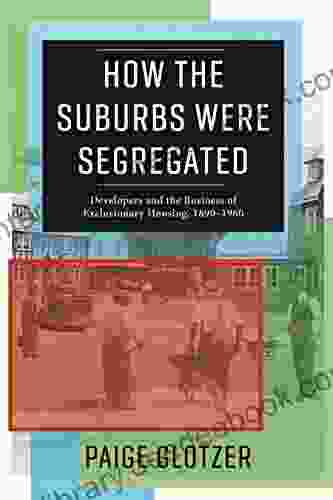`Developers And The Business Of Exclusionary Housing 1890 - 1960 Columbia Studies`

Exclusionary housing practices have been a part of the American housing market for centuries. These practices, which make it difficult or impossible for certain groups of people to live in certain neighborhoods, have had a devastating impact on the lives of millions of Americans.
In this article, we will explore the history of exclusionary housing practices in the United States, from their origins in the late 19th century to their continued use today. We will also discuss the impact of these practices on the lives of people of color, immigrants, and low-income families.
The Origins of Exclusionary Housing
4.6 out of 5
| Language | : | English |
| File size | : | 31864 KB |
| Text-to-Speech | : | Enabled |
| Screen Reader | : | Supported |
| Enhanced typesetting | : | Enabled |
| Word Wise | : | Enabled |
| Print length | : | 316 pages |
The origins of exclusionary housing practices in the United States can be traced back to the late 19th century, when cities began to grow rapidly. As cities grew, they became more densely populated, and land values began to rise. This made it difficult for working-class families to afford to live in the city center.
In response to this problem, developers began to build new housing developments on the outskirts of cities. These developments were often marketed to white, middle-class families. Developers used a variety of tactics to exclude people of color and other marginalized groups from these developments, including:
- Restrictive covenants: These covenants were included in the deeds of homes in many new developments. They prohibited the sale or rental of homes to people of color.
- Redlining: This practice involved banks and other financial institutions refusing to lend money to people of color who wanted to buy homes in white neighborhoods.
- Zoning laws: These laws were used to restrict the construction of new housing developments in certain areas. These laws were often used to prevent the construction of affordable housing in white neighborhoods.
The Impact of Exclusionary Housing
Exclusionary housing practices have had a devastating impact on the lives of people of color, immigrants, and low-income families. These practices have:
- Increased segregation: Exclusionary housing practices have led to the creation of segregated neighborhoods, where people of color are concentrated in certain areas and white people are concentrated in others. This segregation has had a negative impact on the lives of people of color, as it has limited their access to jobs, education, and other resources.
- Reduced economic mobility: Exclusionary housing practices have made it difficult for people of color to move up the economic ladder. By preventing people of color from living in certain neighborhoods, these practices have limited their access to good schools, jobs, and other opportunities.
- Increased racial tensions: Exclusionary housing practices have contributed to racial tensions in the United States. By creating segregated neighborhoods, these practices have fostered a sense of distrust and animosity between different racial groups.
The Future of Exclusionary Housing
Exclusionary housing practices are still a problem in the United States today. However, there are several things that can be done to address this problem. These include:
- Passing laws to ban exclusionary housing practices: Several states and municipalities have passed laws to ban exclusionary housing practices. These laws make it illegal to discriminate against people based on their race, color, or national origin when selling or renting a home.
- Enforcing fair housing laws: The federal government has several laws that prohibit discrimination in housing. These laws can be used to challenge exclusionary housing practices.
- Supporting affordable housing development: Building more affordable housing can help to reduce segregation and give people of color more options when it comes to where they live.
Exclusionary housing practices are a serious problem that has had a devastating impact on the lives of people of color, immigrants, and low-income families. However, there are several things that can be done to address this problem. By working together, we can create a more just and equitable housing market for all.
References
- The Color of Law: A Forgotten History of How Our Government Segregated America by Richard Rothstein
- The Case for Reparations by Ta-Nehisi Coates
- The Wealth Gap: Why America's Working Families Are in Debt and Losing Ground by Heather Boushey and Anne-Marie Slaughter
Additional Resources
- The National Fair Housing Alliance
- The National Association for the Advancement of Colored People
- The Southern Poverty Law Center
4.6 out of 5
| Language | : | English |
| File size | : | 31864 KB |
| Text-to-Speech | : | Enabled |
| Screen Reader | : | Supported |
| Enhanced typesetting | : | Enabled |
| Word Wise | : | Enabled |
| Print length | : | 316 pages |
Do you want to contribute by writing guest posts on this blog?
Please contact us and send us a resume of previous articles that you have written.
 Novel
Novel Page
Page Chapter
Chapter Text
Text Story
Story Genre
Genre Library
Library Paperback
Paperback E-book
E-book Magazine
Magazine Newspaper
Newspaper Paragraph
Paragraph Glossary
Glossary Preface
Preface Synopsis
Synopsis Annotation
Annotation Footnote
Footnote Bestseller
Bestseller Narrative
Narrative Biography
Biography Memoir
Memoir Reference
Reference Encyclopedia
Encyclopedia Character
Character Catalog
Catalog Borrowing
Borrowing Stacks
Stacks Archives
Archives Periodicals
Periodicals Research
Research Journals
Journals Reading Room
Reading Room Rare Books
Rare Books Special Collections
Special Collections Interlibrary
Interlibrary Study Group
Study Group Storytelling
Storytelling Awards
Awards Theory
Theory Textbooks
Textbooks Travis Brant
Travis Brant Jane Kurtz
Jane Kurtz Jenny Mackay
Jenny Mackay Creative Sounds Academy
Creative Sounds Academy Irene Christodoulou
Irene Christodoulou Nick Rennison
Nick Rennison Glenda Austin
Glenda Austin Jamie Woodcock
Jamie Woodcock Mike Duran
Mike Duran Martin Pullen
Martin Pullen Harry Mazer
Harry Mazer Brooks Fiesinger
Brooks Fiesinger Edward Cohn
Edward Cohn Jerry A Mccoy
Jerry A Mccoy Thomas C Schelling
Thomas C Schelling Shell Education
Shell Education Merita S Whatley
Merita S Whatley J M Dunkley
J M Dunkley B E Baker
B E Baker Swifty Kidder
Swifty Kidder
Light bulbAdvertise smarter! Our strategic ad space ensures maximum exposure. Reserve your spot today!
 Dave SimmonsFollow ·15.4k
Dave SimmonsFollow ·15.4k Steven HayesFollow ·6.7k
Steven HayesFollow ·6.7k Jake PowellFollow ·4.3k
Jake PowellFollow ·4.3k Jayson PowellFollow ·2.5k
Jayson PowellFollow ·2.5k Jacques BellFollow ·12.1k
Jacques BellFollow ·12.1k Grant HayesFollow ·13.9k
Grant HayesFollow ·13.9k Curtis StewartFollow ·16.8k
Curtis StewartFollow ·16.8k Ernest ClineFollow ·4.4k
Ernest ClineFollow ·4.4k

 Bo Cox
Bo CoxDiscover the Enchanting Allure of Collingwood, Ontario,...
Nestled amidst the breathtaking landscape of...

 Ralph Ellison
Ralph EllisonThe Street of Clocks Poems: A Poetic Journey Through Time
Welcome to The Street...

 Dwight Blair
Dwight BlairCritical Political Economy of the Middle East and North...
The Middle East and...

 Deion Simmons
Deion SimmonsPerfect Strategies For Painting Amazing Marine Creatures...
Gouache is a...

 Hugh Bell
Hugh BellThe American Republic: Constitution, Tendencies, and...
The American Republic,...
4.6 out of 5
| Language | : | English |
| File size | : | 31864 KB |
| Text-to-Speech | : | Enabled |
| Screen Reader | : | Supported |
| Enhanced typesetting | : | Enabled |
| Word Wise | : | Enabled |
| Print length | : | 316 pages |














